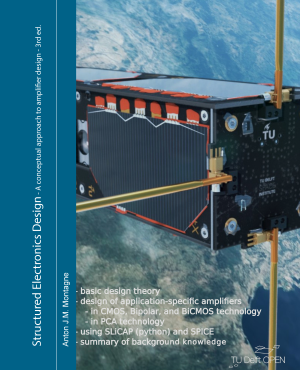Introduction#
In any physical information-processing system, noise is added to the signals. Noise is a collective noun for all undesired current and voltage fluctuations in a circuit. Hence, DC offset voltages and currents including their temperature fluctuations, as well as uncertainty of device parameters including their temperature dependency and ageing effects, can be regarded as noise. All of these effects have in common that they increase the uncertainty that the circuit’s current and voltage variations arise from information-carrying signals only. In this way, all these effects limit the amount of information that can be processed by the circuit.
In this section, we will introduce the main physical mechanisms for noise generation and introduce noise-modeling techniques for amplifiers.
Thermal noise#
The noise caused by the thermal movement of electrons in conductive elements is called thermal noise or Johnson noise. In 1928, J.B. Johnson [55] experimentally found that thermal noise variance was proportional to the absolute temperature. His colleague at the AT&T Bell labs, H. Nyquist [56] explained this. At constant temperature, the generation of thermal noise is a stationary and ergodic process.
The thermal noise in resistors can be modeled by a noise voltage source \(V_{n}\) in series with a noise-free resistor or a noise current source \(I_{n}\) in parallel with a noise-free resistor (see Fig. 587).
Fig. 587 Models for noisy resistors (A and B) and for a noise-free resistor (C).#
These thermal noise sources have a Gaussian amplitude distribution density function and a uniform \ or white power spectral density up to very high frequencies. The power spectral densities of \(V_{n}\) and \(I_{n}\) of a resistor with value \(R\) are given by:
where \(T\) represents the absolute temperature in K, and \(k\) the Boltzmann constant: \(k=1.38\cdot10^{-23}\) in J/K\(.\)
Shot noise#
Variations in the transport of charge carriers across a potential barrier is the cause of so-called shot noise. Currents through PN junctions have an associated shot noise current. Shot noise current sources have a Gaussian distribution density function and a uniform spectral density, as long as the junction transit time is small with respect to the reciprocal value of the frequency. The spectral density of a shot noise current associated with a DC junction current \(I_{J}\) is given by
where \(q\) equals the electrical charge of the charge carrier: \(q=1.6\cdot 10^{-19}\) C.
Excess noise#
Fluctuations in conduction mechanisms give rise to so-called excess noise. Excess noise is found in resistors, in electrolytic capacitors and in semiconductor devices. The amplitude distribution function of excess noise sources is Gaussian, and the spectral density is inversely proportional to the frequency.
In resistors, the spectral density is usually modeled as proportional to the squared voltage \(V_{R}\) across the resistor:
where \(K\) is a material constant.
Excess noise in resistors is usually specified in \(\mu\)V/V/decade: the ratio of the RMS noise voltage \(v_{n}\) in \(\mu\)V and the DC voltage \(V_{R}\), over a frequency range of one decade. The constant \(K\) can then be found by equating \(v_{n}^{2}\) with the integral of the voltage noise spectral density over one decade:
from which we obtain
The excess noise figure \(N\) is often specified in dB. In such cases, \(1\) \(\mu \)V/V/decade is referred to as \(0\) dB. The material constant \(K\) can be derived from \(N\) as
The \(1/f\) corner frequency \(f_{\ell}\) is the frequency at which the spectral density of the excess noise equals that of the thermal noise:
It follows that
in which \(P_{R}\) is the power dissipated in the resistor.
Example
We will evaluate \(K\) and \(f_{\ell}\) for a low-noise metal film SMD 0402 resistor of \(100\Omega\) with a specified excess noise of \(0.03\mu\)V/V, operating at a DC voltage of \(1.5\)V and at a temperature \(T=300\)K.
With the aid of expression (245), we obtain \(K=\frac{0.03^{2} \times10^{-12}}{\ln10}=3.91\times10^{-16}\).
The power dissipation in the resistor \(P_{R}\) equals \(1.5^{2}/100=22.5\)mW. With the aid of expression (246), we obtain \(f_{\ell} =\frac{0.0225\times3.91\times10^{-16}}{4\times1.38\times10^{-23}\times 300}=531\)Hz.
In semiconductors, excess noise is caused by energy traps in the depletion layer of PN junctions or in the oxide of MOS structures. For PN junctions, it is modeled with a noise current source \(I_{n}\) in parallel with the junction. The spectral density \(S_{I_{n}}\)of \(I_{n}\) is
in which \(K\) and \(\alpha\) are material constants and \(I_{J}\) is the DC current through the junction.
Noise temperature#
The noise power of a source is sometimes defined with the aid of its noise temperature. The noise temperature \(T_{n}\) is defined as
in which \(P\) [W] is the available noise power
, \(B\) [Hz] is the total bandwidth over which the noise power is measured, and \(k\) [J/K] is the Boltzmann constant.
